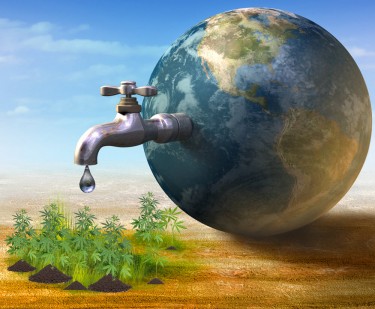
The Dirty Water Secret Of Cannabis – Are Cali Cannabis Growers Tapping Unregulated Groundwater Wells?
Agriculture uses a lot of water, so reckless irrigation practices like diverting water from rivers and streams can cause massive damage to wildlife and disrupt the flow and balance of nature. With the extent to which marijuana is needed, sensible irrigation practices are a must when growing marijuana, especially in states like California that are known for their droughts and marijuana problems.
DEMANDS RESEARCH
For this reason, a research group from UC Berkeley’s Cannabis Research Center examined the water source data and irrigation practices of licensed marijuana farms in the eleven major marijuana-producing counties across California, including Lake, Santa Cruz, Luis Obispo, Humboldt, Nevada, Monterey, San Luis, Sonoma, Mendocino, Yolo, Santa Barbara and Trinity.
The researchers note that California marijuana farms are mostly located in areas that don’t have access to centralized water transportation systems or regulated aquifers like many other crops. This is due to the illegal status of the plant, which pushed growers to more remote regions. Despite the shift from prohibited crops to legitimate, taxed commodities, the authors make it known that the current geographic distribution of farms still resembles the legacy of Prohibition.
The good thing is that the marijuana farms considered rarely depended on streams for water. However, the source of irrigation preferred by most of them, groundwater wells, is hardly a safer alternative, if even to be considered as an alternative.
Theodore Grantham, one of the researchers, explained that wells drilled near streams in upland watersheds can cause rapid depletion of stream flow, comparable to direct surface water diversions. Abstracting water from these wells can disrupt surface water and aquatic ecosystems by absorbing water that ended up being diverted into streams.
In nine of the 11 counties, groundwater wells accounted for over 75% of marijuana farm water use. Additionally, in eight of these counties, more than 25% of farms are connected to wells that are located outside of aquifers per state water use ordinances.
Grantham explained that the majority of marijuana farms are located outside of groundwater reservoirs controlled by the Sustainable Groundwater Management Act (SGMA). As such, good use poses an important but largely unregulated threat to streams in this region.
This was identified by the researchers as an apparent information gap that needed to be addressed.
As you might expect, the larger the marijuana farm and its acreage, the more groundwater is used for its irrigation; Meanwhile, farms that receive more rainfall or have a stream use less groundwater.
Another critical note is that these discoveries don’t cover the full extent of groundwater use for marijuana cultivation in California. There are also unregulated companies.
The result of a machine learning model taught using data from licensed farms in Northern California implies that sixty percent (which is the majority) of unlicensed farms are likely to use groundwater wells if they mimic the type of patterns used by the regulated industry will
This research emphasizes the need for further studies that would raise awareness of the impacts of groundwater use, particularly outside of controlled groundwater basins.
THE SITUATION IN CALIFORNIA AND SOME OTHER STATES
From forests to dusty cities in the western United States, illicit cannabis growers are reaching for water in unbridled quantities, although most of the time there isn’t enough for legitimate users to get around. Disputes over water have long existed, but illegal cannabis farms, which are on the rise regardless of legalization in various Western states, add stress during an intense drought.
According to the Cannabis Research Center at the University of California, Berkeley, California, where cannabis has been legal for recreational use since 2016, there are still more illegal marijuana farms than licensed farms.
According to a report from the center, even tiny diversions can dry up streams and harm aquatic plants and wildlife because marijuana’s greatest water needs are during the dry season, when water flow is at its lowest.
Several jurisdictions are fighting back. In May, California’s Siskiyou County Board of Supervisors passed a law banning vehicles with 100 gallons or more of water from using the freeways that lead into desert regions where 2,000 illegal cannabis growing areas are said to use millions of gallons of water per day.
Illegal cultivation erodes valuable surface water and groundwater resources and threatens recreational, residential, and agricultural water uses, the county ordinance said. In other states, such as Oregon, illegal cultivation appears to have increased recently as the Pacific Northwest survived its driest spring since 1924.
According to Mark Pettinger, spokesman for the Oregon Liquor and Cannabis Commission, many farms operate under the guise of being hemp farms that were nationally legalized under the 2018 Farm Bill.
Sheriff Dave Daniel of southern Oregon’s Josephine County estimates that hundreds of illegal crops are being grown there, many of them funded by foreign capital. Despite the fact that so many are growing, funders assume some of them will be lost, so many of them will continue to grow until the marijuana is harvested and sold in the illicit market outside of Oregon.
According to Pettinger, none of the new locations have a license to grow recreational marijuana. Regulators suspended processing new applications until January 2022 after facing a backlog of license applications and an abundance of legalized marijuana in 2019.
According to Daniel, the unlawful growth has had “catastrophic” effects on the availability of natural water supplies. The water table, which marks the subsurface boundary between water-saturated and non-water-saturated soil, is falling, and several streams have dried up much earlier than usual.
FINAL EFFECT
Due to the severe droughts that are occurring in California and the number of illegal cannabis farms that do not receive a regulated water supply, these farmers continue to tap the unregulated groundwater wells to grow their plants.
MARIJIUANA GROWING IN A DROUGHT READ MORE..

CANNABIS GROWING IN A DROUGHT WHAT CAN YOU DO RIGHT?

Post a comment: